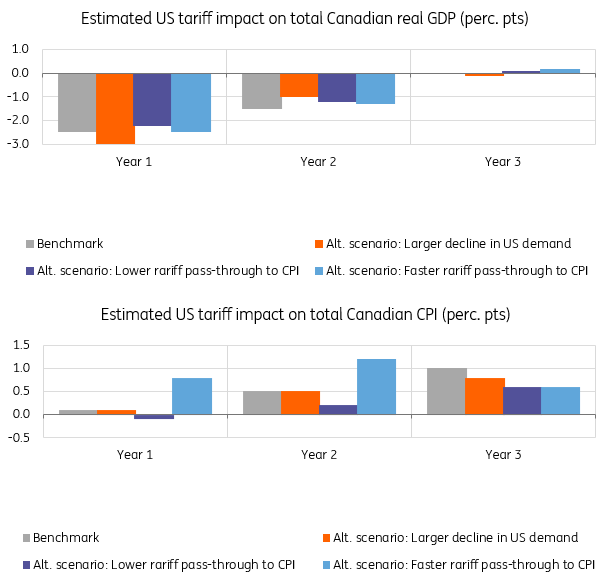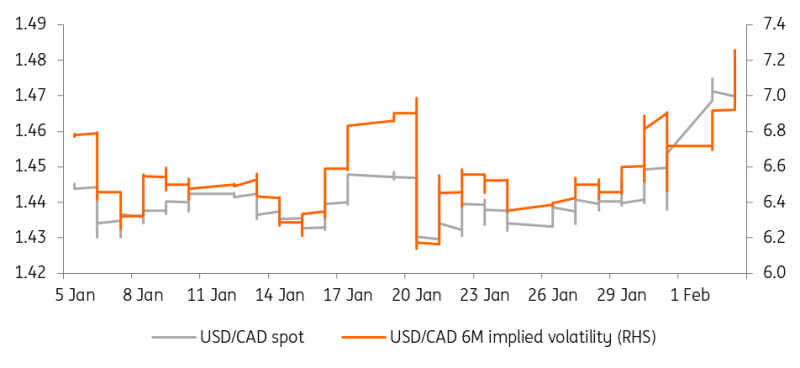Our assumption in December was that a US-Canada trade war could take USD/CAD to 1.50. That is now a clear possibility. The two key factors for FX are how long US tariffs will stay in place and the Bank of Canada reaction. There are upside risks for USD/CAD in the near term, but markets will actively seek hints of de-escalation to buy the undervalued, oversold CAD
USMCA Has Fallen
The US administration has de facto scrapped the USMCA agreement that President Donald Trump himself had negotiated in 2019, as tariffs were imposed on Canada, and Mexico this weekend. You can find our economics team’s initial thoughts on US tariffs here. In this note, we'll be focusing on Canada.
From Tuesday 4 February, all non-oil exports from Canada to the US (around USD 311bn in 2023) will face a hefty 25% tariff, and oil exports (around USD 129bn in 2023) a smaller 10% duty. Canada has already announced retaliatory 25% tariffs on targeted US goods. The first round (around USD 20bn) will also start on Tuesday, and the second round (around USD 85bn) in 21 days.
Canada’s retaliatory measures are aimed at products that should asymmetrically damage US producers and consumers compared to their Canadian counterparts. Trump’s protectionist order includes mechanisms to potentially raise those tariffs in case of retaliation.
BoC Estimates for Impact on Growth and Inflation
Such a move has been unprecedented in recent decades, which poses challenges when estimating the GDP, inflation and market impact on both Canada and the US. For Canada, a framework of trade war economic consequences was provided by the Bank of Canada in its January monetary policy report.
The BoC's baseline assumption in its “quantitative example” is that in the first year the Canadian growth will be around 2.5 percentage points smaller due to US tariffs. The negative growth effect would then disappear by year three. Bear in mind that the mitigating effect for Canadian exporters of the initial negative CAD shock is already embedded in the BoC's scenario.
Inflation is expected to react in a different way due to the assumed gradual pass-through on prices. The BoC's baseline is a negligible impact on consumer prices in year one and 0.5ppt and 1.0ppt in years two and three respectively. By the BoC's own admission, there are significant risks of a faster inflationary effect. An alternative scenario sees a positive shock to CPI worth 0.7ppt in year one and 1.3ppt in year two.
Bank of Canada Estimates for Growth and Inflation Impact of US Tariffs

Source: Bank of Canada
BoC Reaction Function is Crucial for FX
The balance of growth and inflationary effects from US tariffs is of huge importance for FX, as this will determine the Bank of Canada’s policy reaction and potentially widen the USD-CAD rate gap even further.
With 75% of Canada’s exports going to the US – equating to 20% of Canada’s entire GDP – the risk of an outright recession is high. The BoC has already cut the overnight rate 200bp and our call for two additional 25bp rate cuts now is subject to significant risk. The BoC will be concerned about the inflationary threat provided by Canada’s own tariffs, but given the headwinds to Canadian growth and jobs that Trump’s actions pose we suggest the balance of probabilities is skewed towards the BoC offering more support via looser monetary policy.
That could result in a "snowball effect" for CAD, where BoC cuts exacerbate the depreciation already caused by tariff-related risk premium. We cannot exclude the possibility of the Trump administration then accusing Canada of “artificially” depreciating CAD via lower rates to mitigate the tariff impact.
Markets Might Retain Some Scepticism
USD/CAD is currently trading at 1.470, just over 1% higher than Friday’s close. That is a nearly 4% risk premium on the pair when taking Friday’s short-term fair value generated by our model. That likely embeds a dovish repricing in BoC expectations that we should witness in the CAD swap curve today.
The upside risks for USD/CAD remain sizeable, and earlier on Monday we saw the pair test 1.480 before correcting back lower. We think markets can add a greater risk premium on CAD as this is arguably the greatest idiosyncratic Canadian shock in recent decades. A move to 1.50 is a concrete possibility, especially when adding the solid probability of further US Dollar appreciation on the back of the global tariff threat and inflationary risks for the US potentially delaying Federal Reserve easing even further.
USD/CAD Spot and Cost of Hedging Have Spiked

Source: ING, Refinitiv
That said, markets had been somewhat sceptical of Trump’s protectionism plans in the run-up to this weekend, and there may still be some resistance to fully price in a further escalation in the trade war (higher tariffs by the US as counter retaliation) as well as the multi-year economic impact on the Canadian economy. The reasoning here is that tariffs on Canada (and also Mexico) can have a tangible and quick impact on US producers and consumers – automobiles being a case in point – and that Trump might face domestic pressure to lift them.
Unlike in 2018, when US tariffs on Canadian and Mexican steel and aluminium were likely aimed at gaining negotiation leverage ahead of the renegotiation of NAFTA, the next USMCA review is only due in July 2026, and Trump seems to have focused on the border theme for this round of tariffs. If Trump is looking for success on border commitments by Canada, there is a compelling case for a short-lived trade war, especially considering that Canada is projected to have a new Conservative government by the autumn that has already promised to tighten migration controls.
Major USD/CAD Volatility Ahead
To sum up, USD/CAD can easily hit 1.50 in the near term. However, it might struggle to rally much further for now as markets might still lean on the sanguine side, retaining some hopes for a quick trade de-escalation and therefore refraining from adding more CAD risk premium just yet.
Any hint of a trade deal will likely spark sizeable USD/CAD corrections, considering the very stretched CAD short positioning and the large overvaluation. That said, the longer without any de-escalation signs (notwithstanding even higher tariffs), the more USD/CAD’s underlying bullish trend should consolidate, as markets will likely price in a greater impact on Canadian activity and consequently more BoC cuts – unless Canadian inflation spikes, as discussed above.
Short-term USD/CAD volatility looks set to be very elevated as markets should actively trade any headline on the topic and consider Trump’s often unpredictable communication. If by the end of this quarter, we have seen no signal of intent to de-escalate trade tensions, we would expect USD/CAD to be trading above 1.50.
By the end of the year, things may look quite different. If the trade war is indeed short-lived and mutual tariffs are lifted by the end of the year, USD/CAD would then be looking at a very large downside potential (even if starting from a higher point), as markets would price out BoC easing and erase the risk premium on CAD. That scenario is consistent with USD/CAD moving back to the low 1.40s.
Disclaimer: This publication has been prepared by ING solely for information purposes irrespective of a particular user's means, financial situation or investment objectives. The information does not constitute investment recommendation, and nor is it investment, legal or tax advice or an offer or solicitation to purchase or sell any financial instrument. Read more
